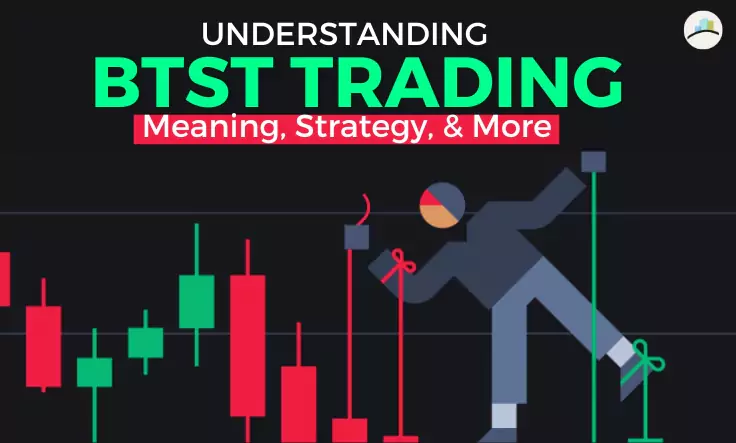In the world of stock trading, numerous strategies cater to different investment objectives and risk appetites.
One such strategy gaining popularity among traders is the Buy Today, Sell Tomorrow (BTST) trade.
This article will delve into the intricacies of BTST trading, covering its meaning, strategy, regulations, and more.
Introduction to BTST Trade
Definition of BTST Trade
BTST trade refers to a trading strategy where an investor buys stocks on one trading day and sells them the next trading day.
Unlike regular delivery-based trading, where stocks are held for a more extended period, BTST trade aims for quick profits within a short timeframe.
Importance in Stock Market
BTST trading holds significance for both seasoned traders and beginners looking to capitalize on short-term market movements.
It offers an opportunity to exploit price differentials between consecutive trading sessions, thus potentially maximizing returns.
Understanding BTST Trade
Buy Today, Sell Tomorrow (BTST)
The BTST strategy revolves around leveraging market fluctuations occurring overnight.
By purchasing stocks on one day and selling them the next, traders aim to capitalize on price movements within this brief timeframe.
Concept and Mechanics
The mechanics of BTST trading involve executing buy orders during the trading hours of one day and selling the acquired stocks on the following day.
This strategy relies on timely decision-making and efficient execution to lock in profits before market dynamics change.
Differences from Other Trading Strategies
Unlike intraday trading, where positions are squared off within the same trading day, BTST trading extends the holding period to the next trading session.
It offers a middle ground between short-term and long-term trading, catering to investors seeking relatively quick returns without committing to extended holding periods.
Benefits of BTST Trade
Quick Turnaround
BTST trading enables swift capital turnover, allowing traders to realize profits within a short span.
This rapid turnaround time appeals to those seeking to capitalize on short-term market movements.
Maximizing Profit Opportunities
By leveraging overnight price fluctuations, BTST traders can potentially amplify their profit margins compared to conventional delivery-based trading.
This strategy facilitates seizing fleeting opportunities in the market landscape.
Flexibility in Trading
BTST trading offers flexibility in terms of timing and execution.
Traders can adjust their positions based on evolving market conditions, thereby optimizing their trading strategies to suit their objectives.
Risks Associated with BTST Trade
Market Volatility
The inherent volatility of financial markets poses a significant risk to BTST traders.
Overnight price swings can erode potential profits or lead to unexpected losses, highlighting the importance of risk management.
Overnight Risks
Since BTST positions are held overnight, traders are exposed to overnight risks such as unforeseen market developments, geopolitical events, or economic announcements that could impact stock prices.
Margin Requirements
BTST trading may entail higher margin requirements compared to regular delivery-based trading, as brokers may impose additional conditions due to the short-term nature of the strategy.
Regulations and Compliance
Regulatory Framework
BTST trading operates within the regulatory framework established by financial authorities to ensure market integrity and investor protection.
Compliance with regulatory guidelines is imperative to avoid legal repercussions.
Compliance Guidelines
Traders engaging in BTST trading must adhere to compliance guidelines set forth by regulatory bodies and brokerage firms.
This includes fulfilling margin requirements, maintaining transparency in transactions, and complying with reporting obligations.
Brokerage Rules
Brokerage firms impose specific rules and conditions governing BTST trading, including margin maintenance, order execution policies, and settlement procedures. Traders should familiarize themselves with these rules to navigate the trading landscape effectively.
BTST Strategy Tips
Research and Analysis
Conduct thorough research and analysis before executing BTST trades.
Analyze market trends, study company fundamentals, and assess technical indicators to make informed investment decisions.
Setting Stop Losses
Implement stop-loss orders to mitigate downside risk and protect capital.
Setting predefined exit points helps limit potential losses and preserves trading capital in volatile market conditions.
Monitoring Market Trends
Stay vigilant and monitor market trends closely when engaging in BTST trading.
Keep abreast of relevant news, economic developments, and geopolitical events that could impact stock prices.
Case Studies and Examples
Successful BTST Trades
Explore real-life case studies and examples of successful BTST trades to glean insights into effective trading strategies and risk management techniques.
Learning from Mistakes
Analyze instances of unsuccessful BTST trades to identify common pitfalls and learn from past mistakes.
Understanding the factors contributing to trading failures can help refine your approach and improve future performance.
Tools and Resources for BTST Trading
Trading Platforms
Utilize user-friendly trading platforms equipped with advanced features and tools tailored for BTST trading.
Choose platforms that offer real-time data, customizable charting tools, and seamless order execution.
Analytical Tools
Harness the power of analytical tools and technical indicators to enhance your BTST trading strategy.
Leverage charting software, trend analysis tools, and volatility indicators to identify profitable trading opportunities.
Educational Materials
Avail yourself of educational resources and training programs focused on BTST trading.
Expand your knowledge base through online courses, webinars, and tutorials covering fundamental concepts and advanced strategies.
Real-world Applications of BTST Trade
Industry Examples
Examine real-world applications of BTST trade across various industry sectors, including finance, technology, healthcare, and consumer goods.
Understand how different market dynamics influence trading strategies and outcomes.
Practical Considerations
Consider practical factors such as brokerage fees, transaction costs, and tax implications when engaging in BTST trading.
Factor in these considerations to assess the overall profitability and viability of your trading strategy.
Best Practices for BTST Trading
Risk Management
Prioritize risk management and capital preservation in BTST trading.
Implement sound risk management practices, such as diversification, position sizing, and stop-loss orders, to safeguard against potential losses.
Diversification
Diversify your BTST trading portfolio across different asset classes, sectors, and securities to spread risk and minimize exposure to market volatility.
Maintain a balanced portfolio allocation to optimize risk-adjusted returns.
Patience and Discipline
Exercise patience and discipline when executing BTST trades.
Avoid succumbing to emotional impulses or chasing short-term gains,
This can lead to impulsive decision-making and suboptimal outcomes.
Common Misconceptions about BTST Trade
Get-rich-quick Scheme
Contrary to popular belief, BTST trading is not a get-rich-quick scheme.
It requires diligent research, disciplined execution, and risk management to succeed consistently in the volatile world of stock trading.
Lack of Understanding
Misconceptions about BTST trading often stem from a lack of understanding of its mechanics and underlying principles.
Educate yourself about BTST trading to dispel myths and misconceptions surrounding this strategy.
How to Get Started with BTST Trading
Opening a Trading Account
Open a trading account with a reputable brokerage firm offering BTST trading facilities.
Complete the necessary account opening formalities and fund your trading account to commence trading.
Learning Resources
Equip yourself with the requisite knowledge and skills to excel in BTST trading.
Enrol in educational programs, read books and leverage online resources to deepen your understanding of trading strategies and market dynamics.
BTST Trade vs. Other Trading Strategies
Comparative Analysis
Compare BTST trade with other trading strategies such as intraday trading, swing trading, and position trading.
Evaluate the pros and cons of each approach to determine the most suitable strategy based on your risk tolerance and investment objectives.
Market Trends and Future Outlook
Emerging Trends
Stay abreast of emerging trends and developments shaping the landscape of BTST trading.
Monitor technological advancements, regulatory changes, and market trends to adapt your trading strategy accordingly.
Predictions for BTST Trade
Forecast the future trajectory of BTST trading based on current market dynamics and evolving investor preferences.
Anticipate potential challenges and opportunities to refine your trading strategy and stay ahead of the curve.
FAQs
Is BTST trading suitable for beginners?
Yes, BTST trading can be suitable for beginners with a basic understanding of stock market fundamentals and a willingness to learn and adapt.
What are the key factors to consider before engaging in BTST trading?
Key factors to consider include market volatility, risk management, regulatory compliance, and brokerage rules.
How much capital is required to start BTST trading?
The capital requirement for BTST trading varies depending on factors such as brokerage fees, margin requirements, and individual risk tolerance.
Can BTST trading be automated using algorithmic trading strategies?
Yes, BTST trading can be automated using algorithmic trading strategies that execute predefined trading rules and criteria.
What are some common pitfalls to avoid in BTST trading?
Common pitfalls to avoid include overtrading, lack of risk management, emotional decision-making, and insufficient research and analysis.
Conclusion
BTST trading offers a compelling opportunity for investors to capitalize on short-term market movements and generate quick profits.
By understanding the intricacies of BTST trading, adhering to regulatory guidelines, and implementing sound trading strategies, investors can navigate the dynamic landscape of the stock market effectively.











 1,499
1,499
